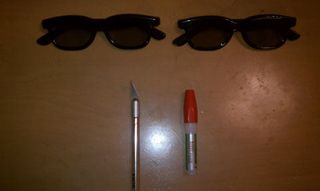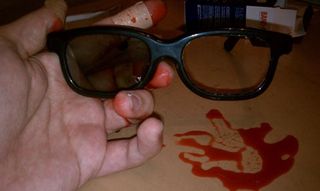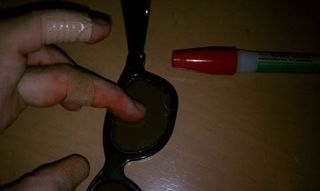De-3D Movies: A Guide To Making Your Own 2D-Glasses

There’s a laundry list of things that I don’t like about 3D. It raises ticket prices by four dollars; makes every movie dimmer; the glasses are incredibly uncomfortable (especially for a prescription glasses wearer like myself) and studios are spending millions developing a technology that nobody seems to want. None of those problems compare to the worst one of all, however: the headaches and nausea.
While it should be noted that not everyone suffers from these afflictions while watching 3D movies, a large cross-section of audiences do. The symptoms are caused by each eye being presented with a different image and results in strain that can cause pain or motion sickness. Due to lack of options or groups of friends that have no issues with the 3D experience, many have been stuck suffering in 3D theaters nationwide. Now you can try to change that.
A couple weeks ago I stumbled on to a site called 2-DGlasses.com. The site sells, for $10 each, glasses that actually can convert 3D movies into 2D movies. Studying the concept, I realized that the glasses could actually be pretty easy to build by oneself instead of buying a pair of pre-made ones. Below you will find a five-step instruction manual to making your own De-3D glasses. Sure, they don’t solve the dimness problem, you still have to shill out the extra money and they are still annoying to wear, but at least you can enjoy the movie-going experience more comfortably.
Step 1: Gather Your Supplies
For this project you will need only a few things: two (2) pairs of 3D glasses; one (1) utility knife (the smaller the better); and extra-strength adhesive. Your work space should be clean and stain-proof.

Step 2: Cutting The First Pair Of Glasses
Using your utility knife, cut out one of the lenses from one pair of 3D glasses – at this stage in the game it doesn’t matter if you cut out the left or right side. The key, however, is that you want to leave a small rim of the lens intact. This rim needs to be wide enough that you can apply extra-strength adhesive to it, but narrow enough that it doesn’t disrupt your field of vision.
CINEMABLEND NEWSLETTER
Your Daily Blend of Entertainment News

Step 3: Cutting The Second Pair Of Glasses
After you’ve cleaned up the blood and bandaged all of your cuts from the utility knife, it’s time to move on to the second pair of glasses. Do not - I repeat DO NOT – cut out the same lens that you did from the first pair of 3D glasses. If you cut out the right lens in step 2, cut out left lens here, and vice versa. This time around, you do not want to leave a rim. Instead, cut as close to the frame as possible so that you have the largest surface area you can get.

Step 4: Putting In The New Lens
Again, clean up the blood as it can smudge the lenses and make the adhesive less effective. Take said adhesive and apply around the rim of the glasses from Step 2. The key is to not use too much. Take the cut-out lens from Step 3 – which you will need to flip in order to fit – and place it in the empty lens from the back and hold it firmly for 30 seconds or however long it takes to let the adhesive dry.

Step 5: Head Off To The Movies
Provided you’re not ready to pass out from blood loss or need to rush to the hospital because you’ve severed your index finger, you’re now ready to enjoy your 3D movie in glorious 2D. Feel free to tap the shoulder of the guy in front of you and tell him that you won’t be vomiting all over the back of his head thanks to Cinema Blend.


Eric Eisenberg is the Assistant Managing Editor at CinemaBlend. After graduating Boston University and earning a bachelor’s degree in journalism, he took a part-time job as a staff writer for CinemaBlend, and after six months was offered the opportunity to move to Los Angeles and take on a newly created West Coast Editor position. Over a decade later, he's continuing to advance his interests and expertise. In addition to conducting filmmaker interviews and contributing to the news and feature content of the site, Eric also oversees the Movie Reviews section, writes the the weekend box office report (published Sundays), and is the site's resident Stephen King expert. He has two King-related columns.
Most Popular






